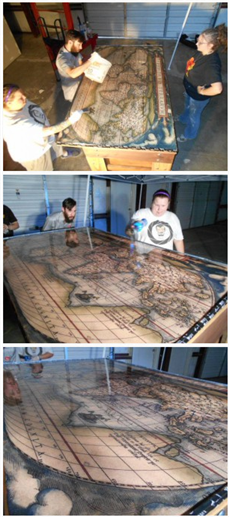“We don’t throw away things, and we don’t throw away people.” That’s the philosophy that drives Mark McCullough of Open Hands Gallery in Boaz, West Virginia. McCullough directs the gallery, which opened in April 2011 as part of the Mentor Network/REM Community Options, providing a place for those with disabilities to express their creativity and foster their self-worth through problem solving and employment.
“We aim to fail every day,” said McCullough. “That means we’re trying and gives us a chance to be creative in our thinking, whether it’s refurbishing a piece of furniture or in our daily lives.” A retired veteran, father of two and a football coach for Parkersburg High School from 1997 to 2008, McCullough aka “Coach Mac” is like a father to many young people in his community as well as the team at Open Hands.

Part of the Open Hands creative team (L to R): Montana Lorraine, Michael "Ribby" Riblet, Ricky Cumpston, LeLe Longwell, Jensen Greenstein, Daniel Simonton and Whitney Kiger.
Open Hands currently employs 17 artists from all walks of life and from all across the country. “We look for people who have some form of disability and want to better themselves,” McCullough stated. These employees turn salvaged items into unique, handmade works of art using their skills in woodworking, painting and welding. “We give them the encouragement, opportunity and resources to expand their creativity. We are teaching these folks and the community that old items still have value in this throw-away society,” he explained. “We don’t give up on our people or the history and value of the items they work with.”
McCullough said, “We try to do the unusual, by taking something and creating it into the opposite of what it was designed to be.” To that end, the Open Hands artists created a bar made from three vintage doors (including a church door!) and a cool world map on top.
Follow along here to see the latest Open Hands collaboration.

Step 1: Two salvaged doors were cut down to build the bar’s frame. The front panel is an old church door, and the sides are from a psychiatric ward (“the psych door”). Walnut wood was used for the trim, while carriage bolts give off an industrial vibe and add contrast in an unexpected way.
Step 2: The team used Watco Danish Oil in light walnut to stain the piece after an overall sanding.
Step 3: The third vintage door was cut to be used as the top surface of the bar.

Step 4: A second coat of light walnut stain was added to obtain the desired color. Everything was given a nice sheen with some linseed oil after it was all completed.
Step 5: Once the bar’s top was completed with the prep stages, it was then ready to add the map. The team found a photo of an old map from the 1600-1700s online and had it blown up by SW Resources to fit the bar’s top surface.
Step 6: After the map was attached to the top of the bar with Titebond Glue, the piece was moved to the clear prep area for pouring the MirrorCoat finish. “This is the star of the show!” McCullough said. “We swear by this finishing system. Our local Woodcraft turned us onto System Three MirrorCoat, and we finish all of our products with it.” MirrorCoat is a pourable, self-leveling bar and tabletop coating that works well on a variety of surfaces, curing to a smooth, glossy finish that is scratch and stain resistant.

Daniel poured the finish while LeLe and Montanta used foam brushes to level the finish out. They used painter’s tape as a barrier around the edge of the bar, but later found that it adhered to the tabletop.
Step 7: LeLe used a torch to get any bubbles out, while Daniel checked the finish.
Step 8: One coat of finish sat for 24 hours. Looking great! However, after taking the tape off, the team had to readjust its plan when the tape bonded with the MirrorCoat. Easy fix! They sanded down the edges, leaving them exposed this time, and simply added another coat of finish. Letting it drift over the sides, they sponged the overage into the fret area around the sides. The second coat added even more shine and protection to the bar top, so it all worked out in the end!


And the completed project – Ta Da!
Another job well done by the Open Hands artists. Several parties have already expressed interest in this unique conversation piece, so it shouldn’t take long to find a buyer.

The Open Hands Gallery is moving next door to its current location around the first of the year, expanding the showroom space from 900 square feet to 6,000 square feet. In addition to their own gallery, their work can also be seen at Nostalgia on Murdoch Avenue in Parkersburg, W.Va., and in their space at Putnam Commons, Putnam Street, Marietta, Ohio. To see more of the projects from Open Hands Gallery online, “like” their Facebook page at Open Hands Seed Project, or view their website at Open Hands Gallery.

We hope you'll be inspired!



